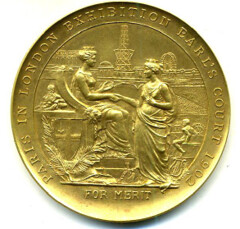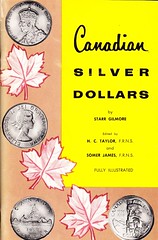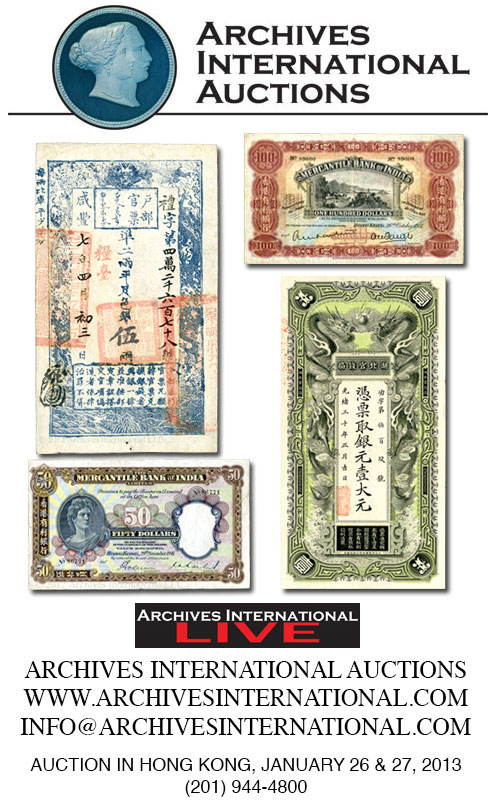
About UsThe Numismatic Bibliomania Society is a non-profit organization promoting numismatic literature. For more information please see our web site at coinbooks.org SubscriptionsThose wishing to become new E-Sylum subscribers (or wishing to Unsubscribe) can go to the following web page link MembershipThere is a membership application available on the web site Membership Application To join, print the application and return it with your check to the address printed on the application. Membership is only $15 to addresses in the U.S., $20 for First Class mail, and $25 elsewhere. For those without web access, write to: David M. Sundman, Secretary/TreasurerNumismatic Bibliomania
Society AsylumFor Asylum mailing address changes and other membership questions, contact David at this email address: dsundman@LittletonCoin.com SubmissionsTo submit items for publication in The E-Sylum, just Reply to this message, or write to the Editor at this address: whomren@coinlibrary.com
BUY THE BOOK BEFORE THE COINYou won't regret it! |
- WAYNE'S WORDS: THE E-SYLUM JANUARY 6, 2013
- KOLBE & FANNING’S 2013 NEW YORK BOOK SALE BIDDER OPTIONS
- CHARLES DAVIS AT THE 2013 NEW YORK INTERNATIONAL
- NEW BOOK: COIN COLLECTING ALBUMS
- NEW BOOKS FROM SPINK: JUEDEA AND ROME, ENGLAND AND UNITED KINGDOM
- NEW BOOK: HISTORY OF OTTOMAN COINS - VOLUME 6
- NEW BOOK: THE ANIMALS’ VC: FOR GALLANTRY & DEVOTION
- FREE BOOK: WHITMAN OFFERS FIVAZ LOCAL LEVEL COIN CLUB GUIDE
- BOOK REVIEW: THE 1815 HALF EAGLE
- ARCHIVES INTERNATIONAL 2013 HONG KONG AUCTION
- MORE U.S. COINS AT THE BRITISH MUSEUM
- MORE ON THE U.S. MINT'S ALTERNATIVE COIN METALS STUDY
- NOTES FROM E-SYLUM READERS: JANUARY 6, 2013
- COIN DEALERS AND DALLAS/FORT WORTH, TEXAS
- MORE ON THE 1902 PARIS IN LONDON EXHIBITION MEDAL
- QUERY: BOGHOS PASHA NUBAR MEDAL INFORMATION SOUGHT
- QUERY: HOW WAS THE ALASKA PURCHASE CHECK REDEEMED?
- QUERY: ARMS OF DUNKIRK MEDAL BY ROETTIERS INFORMATION SOUGHT
- THE OBITUARY OF JULES FONROBERT
- COINS MAILING LIST TO SHUT DOWN
- DAVE BOWERS ON NUMISMATIC LITERATURE IN THE 1950S
- QUERY: INFORMATION ON AUTHOR STARR GILMORE SOUGHT
- WILL CANADA ELIMINATE NICKEL NEXT?
- VENDING MACHINES CAN'T ACCEPT NEW $20 BANK NOTE
- BRITISH MUSEUM ACQUIRES SOUTH POLE EXPLORER SCOTT'S MEDALS
- PERTH MINT ISSUES HOLEY DOLLAR AND DUMP
- TEENAGER CAMPS OUT TO BE FIRST AT ROYAL AUSTRALIAN MINT SALE
- ODYSSEY MARINE FACES OPPOSITION TO HMS VICTORY RECOVERY PLANS
- A BOOKCASE/STEAMER TRUNK
- BOOK TRANSFORMS INTO PORTABLE TOILET
- FEATURED WEB SITE: WORLD OF COINS
WAYNE'S WORDS: THE E-SYLUM JANUARY 6, 2013

New subscribers this week include Ray Feller, courtesy of Steve Feller, and Joe Ryan, courtesy of Gary Patterson. Welcome aboard! We have 1,618 email subscribers, plus 207 followers on Facebook.
We'd also like to welcome new advertiser CoinSupplyPlanet.com and returning advertiser Whitman Publishing. Thank you for your support!
This week we open with updates from literature dealers at the New York International show, followed by word of several new numismatic books. Other topics include U.S. coins at the British Museum, the B. Max Mehl building in Ft. Worth, the COINS mailing list and collector Jules Fonrobert.
To learn more about King Farouk's specially-made coins, the Musée d’Orsay French medals exhibit, the 1902 Paris in London Exhibition medal, the Dickin medal, Captain Scott's medals, Canadian Silver Dollar author Starr Gilmore, and the book that transforms into a, um, well..., you just need to read on. Have a great week, everyone!
Wayne Homren
Editor, The E-Sylum
KOLBE & FANNING’S 2013 NEW YORK BOOK SALE BIDDER OPTIONS
 Kolbe & Fanning Numismatic Booksellers will be holding their 2013 New York Book Sale at the Waldorf-Astoria Hotel in New York City on Saturday, January 12 beginning at 12:30 pm. Printed catalogues have been delivered to those on the mailing list. Clients attending the sale should bring their copies, as there are very few extra copies available.
Kolbe & Fanning Numismatic Booksellers will be holding their 2013 New York Book Sale at the Waldorf-Astoria Hotel in New York City on Saturday, January 12 beginning at 12:30 pm. Printed catalogues have been delivered to those on the mailing list. Clients attending the sale should bring their copies, as there are very few extra copies available.
As in the past, a PDF version of the catalogue is available from the Kolbe & Fanning website at www.numislit.com. The PDF is handy for searching for items by keywords or when your copy of the catalogue is not conveniently at hand.
Once again, we will be offering free live internet bidding for this auction via the-saleroom.com. Every lot is illustrated in this version of the catalogue and the illustrations can easily be enlarged. Through the-saleroom.com, you may register to bid in the auction, and you may leave absentee bids to be executed by the-saleroom.com staff who will attend the auction. In addition, you may watch the auction take place in real time and directly participate in the live event via your computer. There is no additional fee for using this service: the same buyer’s premium for absentee bidders applies. All bidders should read the catalogue’s Terms of Sale before bidding.
To register to participate in the online auction, go to the-saleroom.com and create an account (a credit card will be necessary to register, though other forms of payment may be used). You will find Kolbe & Fanning listed in the directory of auction houses. The online catalogue is easy to navigate and, as previously mentioned, every lot is illustrated. The following link should lead directly to the catalogue:
www.the-saleroom.com/en-gb/auction-catalogues/george-frederick-kolbe/catalogue-id-2869813
You may also simply go to our www.numislit.com home page and go to Register for live online bidding and view all lots at the-saleroom.com to get to the online catalogue. Please register in advance of the sale, as it will take a few minutes. The sale is relatively small, at 271 lots, but it includes an unusually rich selection of outstanding numismatic works in all fields. We look forward to your participation, whether through the online catalogue or through more traditional methods. Please contact us if you have any questions about participating in the sale.
The last day that faxes and mail bids can be received in the Ohio office is Monday, January 7. After that, bids should be emailed to David Fanning at df@numislit.com, who can be reached by phone at (614) 256-8915 while in New York. Messages left at other numbers may not be received.
CHARLES DAVIS AT THE 2013 NEW YORK INTERNATIONAL
Numismatic literature dealer Charles Davis sends this reminder:
Spink and I will have our usual table at the New York International in the Waldorf-Astoria Thursday January 10 through Sunday January 13. For the show, we have prepared a Price List of some of the items available and have posted it on our website at www.numisbook.com
NEW BOOK: COIN COLLECTING ALBUMS
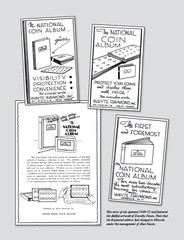 For the past three years I’ve been working on a new book about coin albums
that is far more extensive and complex than my last one on coin boards. Its rather grand title is Coin Collecting Albums, A Complete History & Catalog, Volume One -- The National Coin Album and Related Products Published by Beistle, Raymond & Meghrig.
For the past three years I’ve been working on a new book about coin albums
that is far more extensive and complex than my last one on coin boards. Its rather grand title is Coin Collecting Albums, A Complete History & Catalog, Volume One -- The National Coin Album and Related Products Published by Beistle, Raymond & Meghrig.
What was once conceived as a single volume covering all coin albums and folders almost immediately outgrew the limits of practicality, and I anticipate that this will be the first of many volumes covering the entire spectrum of albums and folders published in the USA since 1927. It’s currently in the layout process, and I expect it to be in print by the time of this summer’s ANA Convention in Chicagomont.

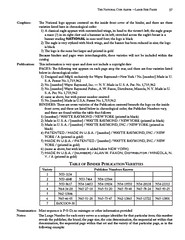
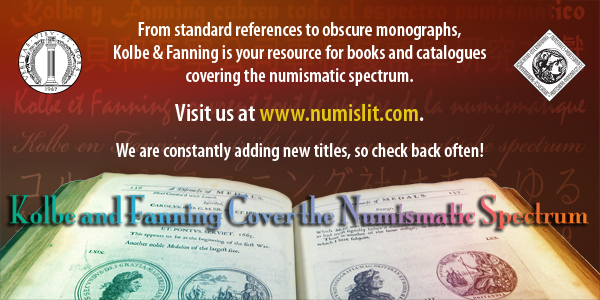
NEW BOOKS FROM SPINK: JUEDEA AND ROME, AND BRITISH INDIA
Judea and Rome in Coins
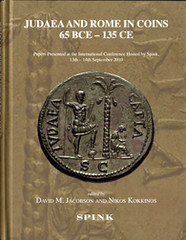 JACOBSON, D.M. & KOKKINOS, N. Judaea and Rome in Coins 65 BCE - 135 CE.
JACOBSON, D.M. & KOKKINOS, N. Judaea and Rome in Coins 65 BCE - 135 CE.
From the Spink web site:
"The Papers in this casebound volume are based on presentations at an international two-day conference held at Spink & Son in London on 13-14 September, 2010. The period covered spans the Roman conquest of Judaea by Pompey through to the last major Jewish uprising against Rome under Simon Bar-Kokhba, encompassing the age of the Herods and the birth of Christianity. The contributors to this volume have pooled their specialist knowledge to illuminate important issues in the history of Judaea and its relationship to Rome. Price £50.00"
To order, see: JACOBSON, D.M. and KOKKINOS, N. Judaea and Rome in Coins 65 BCE - 135 CE (staging.spink.com/books-publications/book-description.aspx?id=68)
The Uniform Coinage of India 1835 to 1947
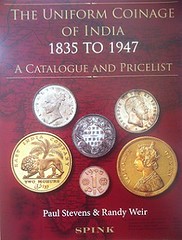
NEW BOOK: HISTORY OF OTTOMAN COINS - VOLUME 6
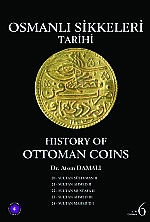 OTTOMAN SULTANS - Suleyman II - Ahmed II - Mustafa II - Ahmed III - Mahmud I
OTTOMAN SULTANS - Suleyman II - Ahmed II - Mustafa II - Ahmed III - Mahmud I
From the end of the sixteenth century onwards, various administrative, military, industrial, commercial, financial and social developments, which occurred within the boundaries of the Ottoman state and throughout the world, were instrumental in exacerbating the economic problems of the Ottoman Empire.
These developments which greatly affected coin minting can be summarised briefly as follows: The silver crisis that emerged due to the closure of the silver mines in the 17th century in the Ottoman Empire was also a factor causing the collapse of the Ottoman monetary system. The standards of the coins produced at the mints outside of Istanbul started to degrade and the state was not able to inspect the fineness and measures of the coins due to the weakness of the central authority. The state which could not control the mints under these difficult circumstances ended the operations of many of them. While the number of mints producing coins had been above 50 at the beginning of the century, as of the mid-17th century the number of active mints came down to less than 10 as indicated in the list below.
The present volume of this work, which is expected to be completed in nine volumes, covers the reigns of sultans Mustafa I, Osman II, Murad IV, Ibrahim and Mehmed IV, and contains:
- Year-by-year chronological information regarding the 67 years of these sultanates;
- The most significant historical developments of this period;
- Detailed information on coins.
This volume includes the details of 28 coins of Sultan Suleyman II, 18 coins of Sultan Ahmed II, 104 coins of Sultan Mustafa II, 346 coins of Sultan Ahmed III and 335 coins of Sultan Mahmud I; i.e. 831 gold and silver coins. Additionally, the book provides the local history of nearly 50 provinces which issued coins during these reigns and examines the characteristics of the coins minted in these provinces.
An inventory of the coins belonging to the sultans is provided at the end of the book.
Heading: History of Ottoman Coins - Volume 6
Author: Dr. Atom Damali
Language: Turkish and English in the same book
Pages: All in colour, 420 pages
Published By: Nilüfer Damalý Education, Culture and Environment Foundation
Size: 210 x 297 cm
Binding: Hard cover
For more information, or to purchase, see: History of Ottoman Coins - Volume 6 (www.niluferdamalivakfi.org/eng/gallery.asp?ID=36&CID=&PID=476&do=showdetails)
NEW BOOK: THE ANIMALS’ VC: FOR GALLANTRY & DEVOTION
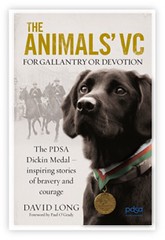 E-Sylum readers have seen a number of articles over the years about the Dickin Medal. Known as "the Animals' Victoria Cross", the medal has been awarded to brave dogs, cats and even pigeons for their service to mankind.
E-Sylum readers have seen a number of articles over the years about the Dickin Medal. Known as "the Animals' Victoria Cross", the medal has been awarded to brave dogs, cats and even pigeons for their service to mankind.
Well now there's a book about the Dickin medal. Sadly for numismatists, the book has no information about the medals themselves. But it does compile a number of great stories about the exploits of the animals who have won them, and it looks like a good read. I bought a copy on eBay last week (only $10 including postage). It's a nice hardcover book with dust jacket, and looks like interesting reading. I found the following on the author's web site.
Recognising the most extraordinary achievements of animals in war - including pigeons flying through enemy lines, a life-saving cat on a Royal Navy destroyer, and Army dogs sniffing out IEDs in Afghanistan - the PDSA Dickin Medal remains the most prestigious award of its type anywhere in the world, with just 64 awarded in its near 70 year history.
Now for the first time a new history, authorised by the People’s Dispensary for Sick Animals, details every one of their remarkable stories. Describing with moving testimony the individuals and their exploits, it explores the remarkable bonds which develop between animals and the men and women they serve alongside and covers the period from the Blitz to the present day.
Produced with the full cooperation of the PDSA, a royalty from every sale will go to save sick animals.
I’ll lend the book to my twelve year old son Tyler - he loves dogs and may be interested in some of their stories. By the way, I'd like to publicly thank reader Bob Neale who read my earlier note about Tyler's interest in dog coins. A package arrived yesterday from Bob for Tyler - it was a nice proof set of four silver Canadian 50-cent pieces, each of which features a different breed of dog. He was delighted. What a generous gift! Thanks!!
For more information, see: www.davidlong.info/the.animals.vc/
FREE BOOK: WHITMAN OFFERS FIVAZ LOCAL LEVEL COIN CLUB GUIDE
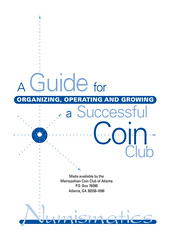 Whitman Publishing in its email newsletter this week offered a free book ... a free pamphlet really. What a magnanimous act I thought. I couldn't wait to download and print it.
Whitman Publishing in its email newsletter this week offered a free book ... a free pamphlet really. What a magnanimous act I thought. I couldn't wait to download and print it.
Written by cherrypicker guru Bill Fivaz ten years ago he has compiled some useful tips for local coin collectors as he has in his books on identifying scarce coin varieties. The information is just as useful today as it was ten years ago.
The subject is local coin club management. Wow, is this timely. Local clubs have been dying off as membership continues to decline in recent years. Perhaps our lifestyles are changed, we have vast more opportunities for vocational activities, but here are some suggestions to increase interests in a local coin club.
The benefits of coin club membership far outweigh winging it alone in collecting. Members have a chance to learn a lot and view some numismatic items new to them. And obtain some new items for their collection.
I cannot explain why the drop-off in coin clubs recently. Perhaps it just stops being fun to attend. I have been a member of local coin clubs for 62 years, perhaps two dozen clubs over the years as I moved around the nation for military service, college and employment. I found a coin club in every new location and took an active part. Probably seen it all, experienced every possible activity at club meetings. My endorsement: The good far outweighs the bad.
Sponsored by The Metropolitan Coin Club of Atlanta, Bill's local club, the pamphlet, titled "A Guide for Organizing, Operating and Growing a Successful Coin Club," this pamphlet is well worth viewing. This should be read, not only by every club officer in America, but also by club members. Let's hope it helps reverse the current trend.
Thanks to Bill Fivaz and to Whitman for making it so accessible. And for free! Join a club.
To access the complete book, see: A Guide for Organizing, Operating and Growing a Successful Coin Club (/news.whitman.com/wp-content/uploads/2012/12/guide-coin-club.pdf)
BOOK REVIEW: THE 1815 HALF EAGLE
 Heritage recently announced The 1815 Half Eagle: New Discoveries, a 50 page monograph by David Stone and Mark Van Winkle, edited by Jim Halperin and published by Ivy Press. I now have a copy in hand and here are a few impressions.
Heritage recently announced The 1815 Half Eagle: New Discoveries, a 50 page monograph by David Stone and Mark Van Winkle, edited by Jim Halperin and published by Ivy Press. I now have a copy in hand and here are a few impressions.
First, E-Sylum readers should know I have a soft spot for one-coin books. The ultimate in numismatic specialization, they are an opportunity to record all of the available information, folklore, and images surrounding the known specimens (there are great books about the 1804 Dollar and the 1913 Liberty Nickels). Not every coin is worthy of this special treatment, but the 1815 Half Eagle is a storied rarity certainly deserving of monograph treatment. The authors have put together a fine and useful tribute to this coin, of which just ten genuine specimens are known.
Not unsurprisingly, several E-Sylumites participated in the project, including Mark Borckardt, Roger Burdette, Dick Doty, Saul Teichman, Karl Moulton and Ron Guth. Morten Eske Mortensen helped locate a previously unillustrated specimen held in the Kungliga MyntKabinett (first reported by Joseph Mickley in the early 1870s).
The authors cover what little is known about the early history of this coin and illustrate the earliest printed record of the discovery of the first known specimen as recounted by Elliot Woodward in his 1883 catalog of the William J. Jenks collection. This account is augmented by letters written by Jenks to Mint Cabinet Curator R.A. McClure, discovered in the National Archives by Roger Burdette.
It's a short book by necessity, but still one packed with great information and mentions of a star-studded cast of the great early collectors of U.S. coinage, including Mickley, Col. Mendes I. Cohen, George Seavey, J.N.T. Levick, T. Harrison Garrett, Harold P. Newlin, and Matthew Stickney. Even those of us (which is nearly all of us) who will never own one of these elusive coins should read this monograph. It's a delight for bibliophiles and researchers, chock full of the facts and anecdotes we crave about our hobby.
To read the earlier E-Sylum article, see: NEW BOOK: THE 1815 HALF EAGLE (www.coinbooks.org/esylum_v15n53a03.html)
ARCHIVES INTERNATIONAL 2013 HONG KONG AUCTION
Archives International Auctions, in association with Dynasty Auctions Company, Ltd., will offer the Allen Berk collection of rare Chinese and Asian banknotes at the Harbor Plaza North Point Hotel in Hong Kong.
There will be over 1,000 lots of rare Chinese, Asian and Worldwide Banknotes, coins and scripophily offered with many rarities and discovery notes.
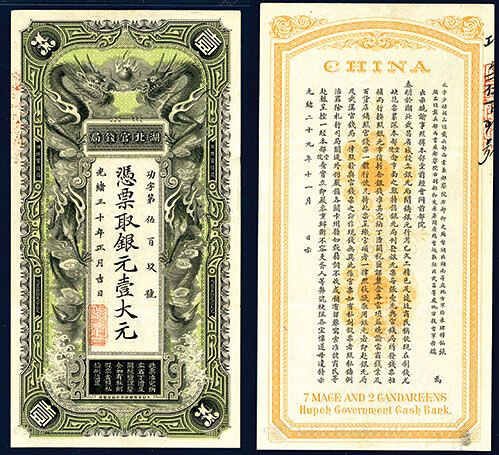
Lot 131 Hupeh Government Cash Bank, 1904 Issue
One of the major highlights of the auction from the Berk collection is a 1904 Hupeh Government Cash Bank, high-grade rarity. "We are proud to offer the China and Asia portion of the Allen Berk Collection and also The Hamtramck Collection, both never offered before at auction and almost all of the banknotes having been off the market between 20 to 50 years," said Dr. Robert Schwartz , President of Archives International Auctions.
The lots will be available for viewing at the NY International Numismatic Convention, January 10-13, 2013 at the Waldorf Astoria Hotel in NYC and at Dynasty Auctions Company, Ltd., Hong Kong from Jan. 23-25.

Lot 1063 Stockholms Banco, Daler Sylvermynt “1666” Issue Banknote
The auction features hundreds of rare items including many Hong Kong banknotes highlighted by the Mercantile Bank of India, 1954, $100 Issue. One of the many worldwide banknote highlights, a 1666 Swedish banknote rarity – a Stockholms Banco, Daler Sylvermynt issue banknote. This note represents one of the first paper money issues in the western world.
The Harbour Plaza North Point Hotel, located at 665 King's Road, Northpoint in Hong Kong. The auction will have a start time of 9:30 a.m. Collectors unable to attend in person may participate live and online, through the Archives International Auctions website, at www.archivesinternational.com . The website also provides a link to a virtual catalog of all the lots as well as information on absentee bidding.
To consign one item or an entire collection, they can be reached at (201) 944-4800 or you can e-mail them at info@archivesinternational.com.
For more information about Archives International Auctions and the upcoming Hong Kong auction, please visit their website at www.ArchivesInternational.com.
To read the complete article, see:
Archives International Auctions To Offer Rare Chinese And Asian Banknotes In Hong Kong
(www.prnewswire.com/news-releases/archives-international-auctions
-to-offer-rare-chinese-and-asian-banknotes-in-hong-kong-185425722.html)
THE BOOK BAZARRE
MAIL BID SALE # 18 CLOSES SATURDAY FEBRUARY 2, 2013
CATALOGS ARE BEING SENT TO ALL INDIVIDUALS ARE ON OUR
MAILING LIST, AND ON REQUEST AT NO CHARGE. THE CATALOG
IS ALSO VIEWABLE ON OUR WEB SITE.
BIDDERS MAY ENTER THEIR BIDS BY MAIL, TELEPHONE, EMAIL OR FAX.
DAVID SKLOW – FINE NUMISMATIC BOOKS
P.O. BOX 6321
COLORADO SPRINGS, CO 80934
TEL: (719) 302-5686
FAX: (719) 302-4933
numismaticbooks@aol.com
www.finenumismaticbooks.com.
MORE U.S. COINS AT THE BRITISH MUSEUM
Saul writes:
Most of the nicer British Museum pieces got there in 1818 from Dorothea Banks. By the way, some surprising condition rarities in the British Museum include
- an 1853-O No Arrows Half Dime - donated in 1906
- 1806 Half Dollar pointed 6 stem not through claw
- 1901-S Half Dollar
- 1869-S Half Eagle, donated in 1987 !!

1853-O No Arrows Half Dime
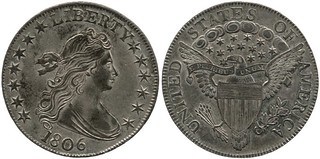
1806 Half Dollar pointed 6 stem not through claw
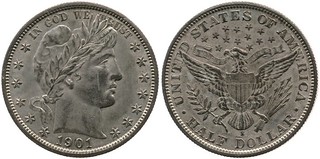
1901-S Half Dollar
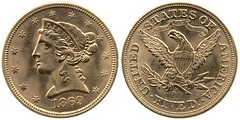
1869-S half eagle
To read the earlier E-Sylum article, see: FEATURED WEB PAGE: BRITISH MUSEUM U.S. HOLDINGS (www.coinbooks.org/esylum_v15n54a20.html)
MORE ON THE U.S. MINT'S ALTERNATIVE COIN METALS STUDY
 In regard to the comment from Dave Lange about the alternative metals study and your follow-on comment, the U.S. Mint was required to perform the alternative metals study by law. According to the Coin Modernization, Oversight, and Continuity Act of 2010 (Public Law No. 111-302), the U.S. Mint was told to "conduct any appropriate testing of appropriate coinage metallic materials" and "solicit input from or otherwise work in conjunction with entities within or outside of the Federal Government" in order to "develop and evaluate the use of new metallic materials."
In regard to the comment from Dave Lange about the alternative metals study and your follow-on comment, the U.S. Mint was required to perform the alternative metals study by law. According to the Coin Modernization, Oversight, and Continuity Act of 2010 (Public Law No. 111-302), the U.S. Mint was told to "conduct any appropriate testing of appropriate coinage metallic materials" and "solicit input from or otherwise work in conjunction with entities within or outside of the Federal Government" in order to "develop and evaluate the use of new metallic materials."
The law requires the U.S. Mint to report "[b]efore the end of the 2-year period beginning on the date of the enactment of this Act, and at 2-year intervals following the end of such period" with "detailed recommendations for any appropriate changes to the metallic content of circulating coins in such a form that the recommendations could be enacted into law," "include recommendations for changes in the methods of producing coins that would further reduce the costs to produce circulating coins," and minimize the alterations that would have to be made "to coin-accepting and coin-handling equipment to accommodate changes to all circulating coins simultaneously." The report cannot recommend that "a specification change that would facilitate or allow the use of a coin with a lesser value produced, minted, or issued by another country, or the use of any token or other easily or regularly produced metal device of minimal value, in the place of a circulating coin produced by the" U.S. Mint.
Since the law was signed by President Obama on December 14, 2010, the report was due to congress by December 13, 2012.
Restrictions placed on the study by congress made it a lesson in futility. While reading the full 400-page report it was evident that there are no alloys that would make U.S. coins unique and be able to satisfy all of the competing interests especially the coin-operating equipment lobby. Since the U.S. Mint was required to do this study, they did their job and made as much news by recommending nothing as they would have by recommending anything.
Congress will have to show leadership in this matter. After all, Article I, Section 8 of the U.S. Constitution says that “The Congress shall have Power... To coin Money, regulate the Value thereof...." Congress passed the laws that govern what coins are produced, where they are produced, what the metal content will be, and sometimes the design of the coins (see 31 USC § 5112). There is not much the U.S. Mint can do without an act of congress.
If the U.S. Mint was being run like a business, the one and five cent coins could be classified as loss-leaders since other coins generate the profits (seigniorage) that provides the U.S. Mint with a healthy profit. To make profits even stronger, congress could eliminate the one-dollar note and reap a 72-cent profit (based on 2011 costs) for every dollar coin put into circulation. But that is another issue for another time!
COIN MODERNIZATION, OVERSIGHT, AND
CONTINUITY ACT OF 2010
(www.gpo.gov/fdsys/pkg/PLAW-111publ302/pdf/PLAW-111publ302.pdf)
31 USC § 5112 - Denominations, specifications, and design of coins
(www.law.cornell.edu/uscode/text/31/5112)
To read the earlier E-Sylum article, see: NOTES FROM E-SYLUM READERS: DECEMBER 30, 2012: Why Bother Studying Alternative Cent and Nickel metals? (www.coinbooks.org/esylum_v15n54a09.html)
NOTES FROM E-SYLUM READERS: JANUARY 6, 2013
Web Site for Early Coins of Myanmar (Burma) Book
 Web site visitor Sophie Mahlo in Berlin writes:
Web site visitor Sophie Mahlo in Berlin writes:
My father just published a book that appeared on your blog The E-Sylum. For his birthday, my brother and I created a website around that book. It can be visited at www.earlycoinsofmyanmar.com . As you will see, the site is still in progress. But we would be still grateful, if you could mention it in your next post.
To read the earlier E-Sylum article, see:
NEW BOOK: THE EARLY COINS OF MYANMAR (BURMA)
(www.coinbooks.org/esylum_v15n50a03.html)
Memphis Speakers Series Call for Papers
Memphis is the paper money speaking event of the year! Be there with your great presentation! We invite presentations on any fiscal paper or fiscal paper tie-in topic. We will have a packed program. Deadline for submissions is April 1st so we have adequate time to organize the program and to send out press releases advertising your talk. Talks are scheduled on the hour throughout the show. Each talk is allotted 50 minutes, which includes time for questions.
For more information, contact
peterhuntoon@embarqmail.com
.
More Unlisted Federal Coin Exchange Auction Catalogs
I have two Federal Coin Exchange auction catalogs not listed in Gengerke:
7 - 31 - 49 309 Lots 5 pages
7 - 28 - 53 401 Lots 7 pages
This will fill a few more holes in the sequence of catalogs.
Regarding the date of the Federal Coin Exchange auction, Bruce W. Smith writes:
This reminded me of an amusing incident in my younger days. In the early 1980's, I published a journal on far eastern numismatics called East Asia Journal. In one issue I decided to run a small auction of coins I had for sale. The magazine only came out quarterly (actually it came out irregularly), so I chose a closing date that seemed appropriate. But there were delays, so I kept moving the date a few days farther and a few days farther. When the magazine finally came out, the closing date ended up at February 30th. Someone from the Netherlands wrote to say -- perhaps tongue in cheek -- that they don't have a February 30th in Europe. Of course, he was right.
To read the earlier E-Sylum article, see:
FEDERAL COIN EXCHANGE CATALOGUE MYSTERY SOLVED?
(www.coinbooks.org/esylum_v15n54a11.html)
Comments on the Fortress Paper Anticounterfeiting Article
The article about Fortress Paper has several problems. Crane does not print US currency, and the $5 note has never used color-shifting ink - it's too expensive. Also, the $5 is hardly the only US note to have an "embedded watermark." What the $5 has now is a watermark that actually tells you that the note is a $5 note - no longer a portrait of Lincoln.
That makes it more expensive for counterfeiters who scrub the ink from a genuine note to get a currency-paper substrate - they now have to use a $10 note or higher to get a portrait watermark to use for their $50 or $100 fake. What they have done instead is use $1 notes and print 1988 or earlier $100 images on them - notes that old don't need even the polymer thread, let alone a watermark, OVI-ink, or any of the other current security features.
Crane's "Motion" technology is already in use in several countries (with different images in the thread than the US notes will use). I bought a recent Mexican note to show this feature to my Summer Seminar students. I'll be looking for the new Moroccan note to see how its features work.
To read the earlier E-Sylum article, see:
DURASAFE COMPOSITE BANKNOTE PAPER ANNOUNCED
(www.coinbooks.org/esylum_v15n54a15.html)
Van Arsdell's Website on Celtic Coinage
I like the way Bob Van Arsdell's site on Celtic coinage works, but why aren't the coins in color?
Bob Van Arsdell responds:
One answer to the question "why aren't the plates in color?" is that no one has color images of the ca. 1000 types known. Many are locked up in collections inaccessible to the public, and some types are so rare, they haven't even been seen for decades. To capture 1000 color images from coins spread across the globe could be a lifetime's work in itself, and remember if you can't find one image, you can't complete the catalogue.
This should pose a warning to anyone contemplating a new book project – often the most difficult part of writing a catalogue for an obscure series is finding coins and obtaining pictures. Most people would think the background research is the tough part – it isn't, it's assembling the plates.
The question also resurrects an old debate about whether coin plates should even be in color in the first place. Over the years, the debate has fallen on the side of color. It certainly makes coins easier to sell if there are color plates in auction catalogues, that's why auction houses prefer them. Auctioneers also have the coins in their possession, so obtaining color images is easy. Furthermore, using color is no longer the prohibitively expensive proposition it once was. I like color for auction catalogues, and books explaining coins to the general public.
However, there is an persistent tradition in scholarly numismatic publication, especially in Britain, that the plates should be in black and white. This stems from the fact that color can actually get in the way of seeing an image. If you have ever looked at a catalogue with dozens of heavily patinated examples of small bronze coins, you have seen the problem. Dark tarnish on silver coins presents another obstacle to clarity. I believe the British community has the best approach for academic works – black and white promotes interpretation better than color.
To read the earlier E-Sylum article, see:
ELECTRONIC OPTION FOR PLATES IN NUMISMATIC LITERATURE
(www.coinbooks.org/esylum_v15n54a14.html)
King Farouk's Specially-Made Coins
The photo of King Farouk of Egypt surprised me. I have seen many images of him, but all from the 1950's or later or on Egyptian paper money. In those images he is rather fat -- not the good looking guy we see in the photo. He was well known as a playboy; now I see why. Having unlimited funds to buy coins, he particularly liked gold coins. Rumor has it that when he traveled to other countries, he sometimes visited mints, and they sometimes made coins for him -- that is, they would pull out old dies and make coins, some of which might not have existed before.
To read the earlier E-Sylum article, see:
NOTES FROM E-SYLUM READERS: DECEMBER 30, 2012:
More on the King Farouk Photo
(www.coinbooks.org/esylum_v15n54a09.html)
Musée d’Orsay French Medals Exhibit
To read the earlier E-Sylum article, see:
NEW CATALOG: FRENCH MEDALLIC ART IN THE 19TH AND 20TH CENTURY
(www.coinbooks.org/esylum_v15n47a05.html)
More on Chinese Writing
The first line consists of three characters which read: xin qian bi (in modern pinyin romanization). The old Wade-Giles rendering would be: hsin ch'ien pi. In both cases, the first word is pronounced like "shin"; the second like "chee - en; and the third like "bee". Xin means "new"; qian and bi both mean "money."
The second line reads: nu mi si * no wa. Chinese has no "mis" sound, so requires two characters to get that one sound. Chinese has no "v" sound, so "wa" is as close as they can get.
In all cases, these are Mandarin pronounciations. Mandarin is the western name for the national language of China. Now called "putonghua" in mainland China or "kuoyu" in Taiwan, this was originally the dialect spoken around Beijing a few hundred years ago.
There were and still are many local dialects in China. The farther two places are from each other, the less likely people from those places can understand each other in spoken language. Because government officials served in all parts of the country and often rotated to different locations during their careers, the dialect spoken in the capitol was chosen as the official government language. Every official had to learn it.
Today, local dialects are still spoken in China (and Taiwan), but every college student learns the national language. The written language is the same all over China and Taiwan, though in China they have simplified the writing of many characters. Everyone can read it, but they pronounce it differently depending on dialect. One often sees the phrase "written in Mandarin" or "Mandarin characters", but there is no such thing. Mandarin is one of many dialects, and there is no way to "write" Mandarin or any dialect -- except in western letters or phonetic symbols.
To read the earlier E-Sylum article, see:
NOTES FROM E-SYLUM READERS: DECEMBER 30, 2012: More on the Translation of "Nummis Nova"
(www.coinbooks.org/esylum_v15n54a09.html)
More on Angelo Rosato
Martin’s catalog lists 174 elongated tokens issued by Rosato up to that time, most with a mintage of between 100 and 250 examples. Subjects include John F. and Robert F. Kennedy, the Rev. Dr. Martin Luther King, jr., Richard M. Nixon, St. Christopher, the Capitol, Neil Armstrong, Expo 67, Christmas greetings, and of course Rosato’s own “numismatic self-portraits” (advertising tokens). Rosato’s Encyclopedia lists an additional 186 of his tokens. Rosato was still going strong in 1998 when he published a 300-page supplement to the Encyclopedia which listed, among other things, 78 more of his rolled tokens.
To read the earlier E-Sylum article, see:
ANGELO ROSATO, 1921 - 2012
(www.coinbooks.org/esylum_v15n54a07.html)
Numismatic Gaffe in Pearl Harbor Movie
Apropos currency errors in movies, I once saw a movie set in Pearl Harbor just before the attack of December 7, 1941 (I believe it was "Pearl Harbor," released in 2001, but I am not positive now; it might have been the much-earlier "Tora, Tora, Tora.") wherein a character lays a dollar bill on a bar top with the word "HAWAII" clearly visible on the back.
The "HAWAII" notes were, of course, not issued until the Summer of 1942. I am assuming that the prop man was fooled by the fact that the Hawaii ones bore the Series date of 1935.
To read the earlier E-Sylum article, see:
NOTES FROM E-SYLUM READERS: DECEMBER 30, 2012: Numismatic Gaffe in Lincoln Movie
(www.coinbooks.org/esylum_v15n54a09.html)
The Case of the Missing Medals
"Each medal was stored in a yellow envelope with a handwritten subject (all in the same penmanship) and was accompanied by a typed note card with a medal description and a catalog card with the name of the subject and additional information on the importance or relevance of the person to the field. There are more cards and envelopes than medals so I assumed that not all the medals were donated to the library. Out of 30 missing medals many commemorated really big personalities in medicine like Boerhaave, Charcot, Koch, and Leeuwenhoek. Maybe they were sold as more valuable before the rest was given to the library? "
Bob Leonard writes:
I would bet that the thirty missing medals were STOLEN over the years, and no one missed them because they were never cataloged. This is a cautionary note for anyone planning to donate something to an institution that isn't prepared to conserve it and keep it secure. When I attended the University of Illinois many years ago I was shown the coin collection of the (then) World Cultures Museum, and in an envelope marked as holding a Roman gold coin I found a Lincoln cent.
To read the earlier E-Sylum article, see:
QUERY: MEDICAL MEDAL DONOR IDENTITY AND NEW DONORS SOUGHT
(www.coinbooks.org/esylum_v15n53a16.html)
Query: B. Max Mehl’s Radio Broadcasts
Do any E-Sylum readers know if tapes or transcripts exist of Max Mehl’s radio broadcasts, especially concerning the 1913 nickels? And second, were the broadcasts short advertisements or were they longer, similar to a program or what we would now call an “infomercial”?
There’s a new neon sign installed on the Max Mehl Building on Magnolia. Nothing too big or elaborate, but a nice addition nonetheless. Always good to see some interesting neon returning to the streetscape.
B. Max Mehl was the most prolific U.S. coin dealer in the first half of the 20th century. Although he worked in New York for a brief time, he returned to his hometown of Fort Worth and built an empire on prodigious advertising and employed an army of clerks to answer the mail in his very own building, which still stands today. It's nice to see the building is "alive and well".
With the northeastern money centers of New York and Boston being the nexus of U.S. numismatics in the 19th and 20th centuries, Mehl's location was an anomaly. Yet today one of the leading numismatic firms, Heritage, is headquartered in nearby Dallas. I wondered how that came to be - what is it about Dallas/Ft. Worth that led that to happen? So I thought I'd go right to the source and ask Heritage co-founder Jim Halperin what he could tell us about the early history of his firm. I called him this afternoon and had a great conversation. Here's what I learned.
Halperin was born in Boston and was just starting out as a coin dealer when, at the age of 16, he met Steve Ivy at a Boston coin show. At the ripe age of 19, Ivy was already a very successful dealer. The two hit it off and became friendly rivals in the business, often having dinner together at shows around the country. The two stayed close as Jim's business grew.
As a high school student Jim learned computer programming. After college Jim started New England Rare Coin Galleries, also based in Boston. With the help of his father and financing from IBM, NERCG acquired a mainframe computer, and was probably the first coin company to do so. With a hired computer programmer, the machine was soon running inventory and mailing list programs, and hosting a database of coin selling prices.
With the help of this automation and Jim's coin dealing skills, NERCG grew to be the largest coin firm in the U.S. by the late 1970s and Jim turned down a purchase offer of $22 million from Sotheby's in November 1979. Other firms were interested in a deal as well.
Jim said he felt like the Smartest Man in America for not selling after NERCG’s net pretax profit for the first half of 1980 tallied up to over $10 million. But then came the market collapse, bringing a nuclear winter for the previously high-flying coin business. The company limped along, but by 1982 both Halperin and Ivy's firms were in some trouble. Halperin still had business and assets, but not nearly enough to cover debts. In fact, he was insolvent to the tune of $1-2 million, and was advised to file bankruptcy, but instead he resolved to pay all his debts in full.
So here's where the Texas connection comes in. Steve Ivy had been born in Ft. Worth, and was operating his coin business in Dallas. He owned a building and the parking lot across the street. It turns out the parking lot was a godsend. Real estate developers wanted it, and were willing to pay a very good price. Long story short, with funds from that real estate sale, Ivy offered to sell Jim half his company for a non-recourse note if Jim would move to Dallas. Halperin agreed, sold the NERCG name and some of the assets to an employee in Boston, moved to Dallas along with some of his other employees, most notably Marc Emory.
Within ten months their joint coin business had rebounded well enough that Jim was able to pay all his creditors 100 cents on the dollar. Within a year or two he had also paid off the original Heritage note. Thirty years later, Steve and Jim remain equal partners, although now there are seven junior partners (Greg Rohan, Marc Emory, Paul Minshull, Todd Imhof, Ryan Carroll, Cris Bierrenbach and Chris Ivy) at Heritage in addition to the two founders.
And that's the story of how Jim and Steve started Heritage in Dallas.
To read the complete Max Mehl sign article, see:
NEW NEON SIGN AT MAX MEHL BUILDING
(fortworthology.com/2010/09/15/new-neon-sign-at-max-mehl-building/)
Regarding the Paris in London Exhibition medal, there is a listing in British Medals Since 1760 by Col. M. H. Grant (originally run in serial form in the British Numismatic Journal 1936 - 41) under 1902: Paris Exhib., Earl's Court Anon.
While the medal appears to have been previously published, there is no new information to add.
Peter Preston-Morley writes:
I saw one other example, in silver, in a private collection some years ago. The medal is certainly very rare and escaped being listed by the late Leslie Allen in 2004 when he published all the different types of UK exhibition medals, 1840-1909, known to him. Spink produced several variants of medals for functions at Earls Court at the turn of the 20th century, so I suppose it is no surprise they got involved with this one.
Imre Kiralfy, who died in April 1919, was an entrepreneur of considerable note, as your correspondent says. He designed the White City stadium, venue of the 1908 Olympics. At least two medals awarded to his son, Gerald, have surfaced on the British market in recent years and one of them described Gerald as the Architect-in-Chief of the Japan-British Exhibition, 1910.
To read the earlier E-Sylum article, see:
QUERY: 1902 PARIS IN LONDON EXHIBITION MEDAL UNIQUE?
(www.coinbooks.org/esylum_v15n54a13.html)
Unfortunately, I cannot offer any information about the medal mentioned, but I do congratulate the owner for getting a better response from Spink than I did for my medal. Perhaps I can try the kindness of your readers on mine: I have an attractive and clearly rare bronze award medal dated December 1898, engraved with the name Boghos Pasha Nubar, also bearing a tiny SPINK & SON legend. The medal shows the Egyptian pyramids on the Nile, with an Egyptian insignia
What makes this medal interesting and important is that the recipient, an Egyptian Armenian, was one of the most prominent Armenians worldwide during the late 19th and early 20th centuries. He began his career as an engineer and inventor, but later moved into philanthropy (as founder of the Armenian General Benevolent Union) and politics (as an Armenian representative to the Paris Peace Conference in 1919). We know that he participated in various technical expositions, such as the Paris Exposition in 1900. However, I have been unable to identify the specific December 1898 exposition or the nature of his submission for which the prize was awarded. As I mentioned, an inquiry to Spink in London did not help much.
Any readers with information are requested to contact me at Tramaked@aol.com
To read the earlier E-Sylum article, see:
QUERY: 1902 PARIS IN LONDON EXHIBITION MEDAL UNIQUE?
(www.coinbooks.org/esylum_v15n54a13.html)
First of all, Happy New Year!
I am sure that everyone is looking forward to another year of scintillating commentary in the E-Sylum throughout 2013.
Anyhow, I have a question which one of our readers may be able to answer.
Regarding the sale of Alaska by Russia to the United States which was paid for with a cheque for $7.2M from the Treasury Department (New York) in August 1868, I was hoping that somebody may know how this cheque was redeemed.
Were the funds simply deposited by Russia as money on account with the Treasury or did gold bullion get physically transported by ship to Russia? If the latter, does anyone have any information on where the gold itself came from (i.e. was it perhaps issued in bars that were assayed at the Denver Mint's offices over the gold rush period?)
With this check, the United States completed the purchase of almost 600,000 square miles of land from the Russian Government. This treasury warrant issued on August 1, 1868, at the Sub-Treasury Building at 26 Wal, New York, New York, transferred $7.2 million to Russian Minister to the United States Edouard de Stoeckl. The purchase price of the 49th state? Less than two cents an acre. Original located in the National Archives, Records of the Accounting Officers of the Department of Treasury.
To read the earlier E-Sylum article, see:
AN ALASKA PURCHASE TREASURY WARRANT
(www.coinbooks.org/esylum_v15n18a19.html)
I am seeking information on a French 45mm silver medal by Joseph Roettiers - obv: Louis XIV. rev: Arms of Dunkirk with HOC NUMINE FELIX around and DVNKERCA 1689 in exergue.
ANY thing would be helpful - relative rarity, price range, reason why. There is a briefest mention in Forrer of a medal for Dunkirk, but no date no reason.
Ralf writes:
However, in the E-Sylum archive I found a contribution by Bob Leonard in which he mentions that he wrote a biography of Fonrobert in Breen and Gillio’s 2003 edition of "Califonia Pioneer Fractional Gold" (Vol. X, No. 9, Article 13). Since I was unable to get hold of a copy, I don’t know whether Mr. Leonard had access to this obituary (but would guess so).
In any case, it is definitely interesting for numismatic circles outside the California gold specialists to hear about the background of Jules Fonrobert (I am thinking about my peers from the Mexican / South American collecting community, from where I have received questions about Fonrobert in the past). Before I make this translation available to them, I would like to know what Mr. Leonard had written about Fonrobert – maybe somebody could provide me with a scan of the relevant pages of this book.
Foerster, Feodor: „Jules Fonrobert †“, in: Numismatische Zeitschrift, Volume 11, 1879, Wien: Numismatische Gesellschaft in Wien, pp. 446-448.
Jules Fonrobert †. May 22 of last year was the day Mr. Jules Fonrobert passed away in
Freienwalde / Oder after a long period of suffering following a stroke. He was a former
member of our numismatic society and known as an avid coin collector far beyond this
circle.
Born on September 4th, 1831, as the first son of a man of private means, Louis
Fonrobert - founder of the German rubber and gutta percha industry -, who passed away a
few years ago, Jules Fonrobert was of very tender physical constitution. The protection he
needed from a very early age on was the reason why he spent a large part of his childhood
with relatives in a little town near to Berlin. Later he attended to the business school in
Berlin, where he was prepared for a career in commerce, and completed an apprenticeship
with one of the important banks in the city. Following this, he went to New York, where he
spent several years working diligently with the local representative of the House of
Rothschild.
His commercial abilities increased such that he, after his return to Berlin, together
with an uncle, took over his father’s company and led it to unprecedented success, which
established the basis for his not inconsiderable wealth.
Interest in numismatics had already been sparked in Fonrobert during his stay in
America. There he laid the foundation to a general collection of medieval and modern coins,
starting out just like any collector. It was only later, after having studied my specialized
collection of coins and medals from overseas, that he developed deeper interest in this field,
and decided to concentrate on overseas coinage from now on.
Equipped with a rarely encountered vigorous mind and, as mentioned, considerable
financial means, he not only set in motion all coin dealers and collectors known to him, but
he was also able, through his extensive commercial connections, to buy whole collections,
thus achieving unprecedented results in his collecting strive.
Since his business and social responsibilities consumed the majority of his time, he
could not bring order into the massive amount of numismatic material that he assembled, so
he was forced to look for outside assistance. Due to his distinctive knowledge of human
nature, he was able, in 1878 (1), to win one young numismatist, Mr. Adolph Weyl, to devote
himself completely to select, sort and describe those items from the holdings useful for the
collection. Within a short time, the collection grew so rapidly that the decedent came to the
decision to give up the European coins and medals, with the exception of Brandenburg-
Prussia, and to instruct a numismatic auction house with their sale.
After the company chaired by him for many years, had been transformed into a
public corporation in 1871, Fonrobert did have some more time at his disposal and he came
to the decision to edit a work on the numismatic history of the overseas countries, based on
the specialized collection that he still augmented with all his forces, as well as on items
published or present in other coin cabinets. For this purpose, he had drawings and woodcuts
made of many coins.
However, while he was indulging in his hopes of seeing his favourite idea being
completed on a magnificent scale, he was struck by a nervous condition. This forced him in
1877 to have his collection of Brandenburg-Prussia catalogued and brought to auction by the
long-time curator of his collections.
It was only afterwards, facing the fact that his daily declining health would make the
completion of his favourite plan impossible, that the deceased decided with heavy heart to
have a catalogue made of his overseas collection, to save his objective from oblivion, now
that it was impossible to realize it to the planned extent.
Adolph Weyl, knowledgeable long-time caretaker of this magnificent collection,
completed this difficult task within the short period of 1 ½ years, and by this provided an
immense and not to be underestimated service and guide to the coin collectors seeking to
identify coins from overseas.
Let us honour the deceased, who pursued the preparation of his catalogues with an
eagerness seldom encountered, as well as his intentions that did not come to fruition, with
the wish:
Berlin, October 1879
First, pull your copy of E.E. Clain-Stefanelli's Numismatic Bibliography (Battenberg, 1984) off the shelf and turn to p. 1564. Here you will find listed Jules Fonrobert's obituary in the Numismatische Zeitschrift (1879), vol. 11, pp. 446-448. I obtained a copy of this (in German, of course) and translated it myself; this is the same source Mr. Böpple used. (Fonrobert's first name is incorrectly given by Elvira here as Julius.)
An additional short notice is found in Adolf Weyl, Die Jules Fonrobert'sche Samlung ueberseeischer Muenzen und Medaillen. Amerika. I. Abthilung: Nord-Amerika. Berlin, Adolf Weyl, December 1877, Vorwort (pp. v-vi).
Also, though not mentioned in my book, "Fonrobert, Jules 1831-1879 (Germany)" was an Overseas Member of the Royal Numismatic Society from 21 Nov. 1872 until his death 22 May 1879" (R.A.G. Carson and H. Pagan, A History of the Royal Numismatic Society, London 1986, p. 77). He was also a member of the Societe Royale de Numismatique de Belgique 1872-1879 (150th Anniversaire de la Foundation de la Societe...1841-1991, 1991, p. LXX).
Mr. Böpple questions the date of 1878 given in the obituary. He is probably right that 1878 should be corrected to 1868 or maybe 1870. (I omitted this in my account.)
This is not the first time Fonrobert's existence has been challenged. I wouldn't be surprised to learn that "Fonrobert" was a pseudonym for the true owner (see Mr. Battle Born, Mr. Fairbanks, H.R. Lee, etc., etc., and for that matter, Jay Roe himself), though he seems to have been able to join the national numismatic societies of at least three countries under this name if so. In any case, with an exhaustive collection like this, there had to be a wealthy collector behind it. So I think that the biographical details are essentially correct.
The bigger mystery is, how did Fonrobert get all his U.S. coins? So far as I know, he is not listed as a buyer in any U.S. auction of the period, including the time he spent in New York as a representative of the House of Rothschild. No doubt he used agents, but perhaps he ignored the auctions and bought entire collections en bloc as his obituary states.
Finally, here is the text of the Fonrobert material which appeared on p. 81 of the 2nd ed. of California Pioneer Fractional Gold, Wolfeboro, 2003 (not a scan--the book is way too valuable to do this now):
Jules Fonrobert, a wealthy German industrialist, owned one in 1877. When he acquired it is not known; possibly as early as the 1850s, when he was a representative of the House of Rothschild in New York, as he was already collecting coins during his residence there. After his return to Berlin in the late 1850s, Fonrobert decided to concentrate on “overseas” coins, especially including North and South America. The bulk of his holdings were purchased after 1871, however, when he incorporated his factories and withdrew from active management to devote all his time to his coin collection. He corresponded with all dealers and European numismatic societies seeking material, and also used his international mercantile connections, buying entire collections as well as individual rarities. But in 1877 he was seized with a fatal illness and consigned his collection to Adolph Weyl of Berlin, with the proviso that each piece be described in a catalog that would serve as a lasting reference. This Weyl did, listing and illustrating the Arms of California piece as lot no. 1382—the only one of Fonrobert’s 78 pieces of small California gold to be pictured. It was sold February 18, 1878. [1]
On Wednesday, COINS list administrator Ken Connelly of the University of Northern Iowa wrote (on the COINS mailing list, of course):
The most recent message to the Coins list hosted here at UNI was nearly a year ago, January 28, 2012. It seems that the service is no longer needed. Unless I hear a great cry of anguish for the loss, I'm going to pull the plug by the beginning of the coming week.
Bob Fritsch wrote:
Agree. We had a good run but everyone has migrated to other lists. Thanks for running this over the years.
Gar Travis wrote:
First list I ever joined...going to miss the 'ol gal.
Martin Purdy of New Zealand wrote:
I'd like to add my thanks for all the good work in running the "granddaddy" of the coin lists. I must have joined in about 1995 when it was one of the few around. Activity on most traditional lists seems down on what it was - "web forums" seem to have taken over now.
Tony Clayton wrote:
Certainly the Coins List was very interesting when I first subscribed many years ago, and I for one much enjoyed, if mainly as a lurker. I think it does seem that its time has come, sadly, and it has been superseded by some excellent and versatile sites such as the World of Coins.
P. K. Saha wrote:
What would you save by pulling the plug on a sparsely used service which does not consume much of your resources?
I am sure it may be occupying less than 1 MB of storage and negligible bandwidth.
For all you know, it might see a revival.
It remains an historically important list even though it may lack many bells and whistles of Google and Yahoo groups.
I have great deal of nostalgic feeling about this list.
I have not been using this list since it does not permit attachments ( of coin images) which are of much importance to me.
If that can be arranged, perhaps things may change. There could be limit on size of attachment.
Back in 1955, I was fairly well steeped in numismatic tradition, through reading, hardly by first-hand experience. I had only been a coin collector since 1952, although I could say and pronounce numismatist correctly. With a limited budget I mainly collected coins from circulation at the outset, and concentrated on building a numismatic library.
As strange as this may seem today, in the early 1950s scarcely anyone was interested in collecting old coin books, magazines, and catalogues. Members of the Wilkes-Barre (Pennsylvania) Coin Club, on learning my interest, deluged me with piles of copies of The Numismatist, The Numismatic Scrapbook Magazine, and auction catalogues. Concerning the latter, the only one that seemed to have any particular value, perhaps a few dollars, was the 1941 presentation by B. Max Mehl of the William F. Dunham Collection. Others dating back to the previous century were of little or no commercial value.
By 1955 I had developed a number of different specialties. I had an active business in buying and selling pattern coins in an era in which these were a niche at best, and most dealers did not handle them at all. I also enjoyed colonials and collected copper coins of Vermont, Massachusetts, and Connecticut, staying away from New Jersey coppers as my fine friend Jim Ruddy collected those. Anything else, such as Massachusetts Pine Tree shillings, for example, was way out of my financial reach.
Somehow, probably through corresponding about patterns and colonial coins, my image as a buyer far exceeded my financial resources. Many people thought I could write a check for whatever I saw, but this was hardly the truth. To buy one coin I usually had to sell another!
Numismatics was a wonderful hobby then, as it is now. Investors mainly concentrated on bank wrapped rolls and Proof sets, forming a division or niche in the field, but not driving it. The main buyers of coins did so for their collections, and the word investment was hardly ever heard. However, it was a given—just about everyone knew that a fine collection, carefully gathered, would do well upon its sale.
To read the complete article, see:
Remember When: My First Ana Convention
(stacksbowers.com/Blogs/remember-when-my-first-ana-convention.html)
Might any of our readers be able to provide biographical or bibliographical info for Starr Gilmore, the author of Canadian Silver Dollars, 1961? He wrote in a candid and entertaining manner. He didn't avoid stating his opinion. Finding information about him or his other writings has led nowhere. Thus a call for "help." The image of his book's might help refresh some memories.
Gilmore was before Darryl's time. We asked Ron Greene, who writes:
I'm sorry, but I'm not much help. I checked the May 1960 ANA directory for the Spokane, WA area as I have a vague recollection he was from there, but he wasn’t listed there, nor was his name in the C.N.A. 1962 directory. I never corresponded with him and I never met him.
Canadian dollars made at the Royal Canadian Mint since 1952. – Numismatic Scrapbook Magazine : Vol. 25, no. 2 (Feb. 1959). – p. 257 - 254. – very comprehensive review of the details concerning every issue including varieties and quantities allocated to various banks by type
Finale on Canadian dollars. – Numismatic Scrapbook Magazine : Vol. 25, no. 9 (Sep. 1959). – p. 2144 - 2153. – very detailed discussion of published errors concerning the designers and production of dollars and the identification of the principle collectors of Canadian dollars from around the world
Canadian dollars counterstamped “JOP”. – Numismatic Scrapbook Magazine : Vol. 26, no. 4 (April 1960). – p. 964 - 968. – an investigation into the appearance of dollars countermarked ‘J.O.P.’ which were first reported in the Winnipeg Tribune in 1947. Larry Gingras discovered that the issuer was Joseph Oliva Patenaude - a jeweller from Nelson, British Columbia. This article summarizes that story and greatly expands upon the existing body of knowledge about this subject
Canadian silver dollars : voyageurs and commemoratives. – H.C. Taylor; Somer James, Editors. – Winnipeg : Canadian Numismatic Publishing Institute, 1961. – 96 p., ill. – contains technical data and mintage figures for each silver dollar minted from 1911 - 1960
Parliamentary dollar background. – Numismatic Scrapbook Magazine : Vol. 28, no. 3 (March 1962). – p. 660 - 663. – detailed information about the background, production and distribution of the 1939 silver dollar commemorating the royal visit of King George VI and Queen Elizabeth
Double variant (two separate errors) Canadian dollar. – Numismatic Scrapbook Magazine : Vol. 30, no. 3 (March 1964). – p. 601 - 603. – the story of the discovery of a 1950 ‘Arnprior’ Voyageur dollar with both the variation in the normal three water lines at the bow of the canoe and the complete absence of the lower right group of Northern Lights. As of the date of publication, this was the only known example despite the knowledge that two different reverse dies were used for the 1950 production run. Logically many more examples should exist
Canadian dot coins. – Numismatic Scrapbook Magazine : Vol. 30, no. 6 (June 1964). – p. 1545 - 1549. – Elizabeth Wyn-Wood tells the story of why ‘dots’ were intentionally placed on the 1936 dies - including a description of how this was accomplished. She also states that “at least four dies of each denomination were so marked”. Curiously, the official Mint report fails to mention any ‘dot’ coins
Canadian dollar variants. – Numismatic Scrapbook Magazine : Vol. 30, no. 10 (Oct. 1964). – p. 2907 - 2909. – descriptions of silver dollar die varieties and feature errors
Canadian dollar history. – Numismatic Scrapbook Magazine : Vol. 30, no. 12 (Dec. 1964). – p. 3291 - 3293. – discussion of the emotions and economics contributing to a dramatic increase in the value of Canadian silver dollars
Darryl adds:
Note that his last entry relates to an article that discusses the speculative bubble concerning these coins. Of course, that bubble eventually burst in spectacular fashion. From the introduction in the CNB, I quote:
"Currency collecting grew phenomenally in the 1950s and early '60s - so much so that it became near-mania by the mid-1960s to make bulk purchases of the most recent dates. Ticker-tape systems were installed, ‘investment papers' were published, and the catalogues were unable to keep pace with the ever-rising prices. Fuelled by the U.S. coin shortage of 1964-65 and the American government's subsequent decision to both freeze the date at 1964 and to discontinue the production of proof sets, the sale of Canadian ‘proof-like’ sets skyrocketed in demand and price, culminating in the two million sets reserved for 1965 being over-subscribed early on that year’s first business day. The Canadian government’s later decision to fill all orders received caused the ‘coin bubble’ to burst. Shorn of multitudes of speculative ‘investors’, the hobby lay in depression for a few years and then began to gain strength again on a more gradual and sustained basis."
Dick Johnson writes:
Flushed with the apparent success of eliminating their cent coin, Canadians are now considering dispensing with the nickel as well A retired Bank of Canada economist Jean-Pierre Aubry, says the nickel is also becoming obsolete.
His analysis over the years reveal the cent reached a tipping-point for being dumped back in 1982. He states the nickel is reaching that same tipping-point now.,
Interestingly, he notes, when a low value coin is required to be struck in ever larger quantities each year it means the coins are being hoarded and not being returned to circulation. That is now occurring in Canada for the nickel.
It wasn't mentioned in an article this week, but with both the cent and nickel eliminated it will making rounding off easer to the nearest 10-cent multiple
As the penny is set to begin retirement next month, there are already calls to put the nickel out to pasture as well.
The Royal Canadian Mint starts collecting one-cent coins on Feb. 4 for melting and recycling of the metal content, with some six billion pennies expected to be surrendered by Canadians over the next six years.
Finance Minister Jim Flaherty announced the surprise demise in last year's budget, saying the penny had become a nuisance.
And a former Bank of Canada economist says the nickel is also becoming obsolete, and should be next in line for retirement.
"We see less and less people now ... digging in their wallets for nickels," Jean-Pierre Aubry said in an interview. A retired 30-year veteran of the Bank of Canada, Aubry has been a leading proponent of withdrawing the one-cent piece from circulation.
In papers and presentations for Desjardins Group over the last few years, Aubry used economic models to show that the penny should actually have been killed in about 1982.
That was a tipping point, as more Canadians hoarded the coins and the Royal Canadian Mint was pressed to churn out billions more to keep retailers stocked, costing the government up to $11 million annually.
The last pennies minted on May 4 in Winnipeg were costing about 1.6 cents each to manufacture. Aubry also estimates retailers, banks and consumers have absorbed about $140 million in handling costs each year, creating an unnecessary drag on the economy.
Even though Finance Canada faces a one-time net cost of $38 million to retire the penny, the long-term savings to government and to the economy will be substantial.
Aubry argues the nickel will soon hit the same tipping point the penny did in 1982, as Canadians hoard them in greater numbers, forcing the mint to distribute up to 350 million each year to meet retail demand.
"It's a sign that the coin is not well used," he said.
To read the complete article, see:
Will nickel follow penny out of Canadian coin circulation?
(www.cbc.ca/news/business/story/2013/01/02/can-money-nickel-penny-coin.html)
Thousands of vending machines still can't digest those plastic $20 bank notes the government released two months ago, with machine owners blaming the Bank of Canada for their problems.
As many as half a million machines that scan bank notes needed reprogramming to accept the radically redesigned $20 bills, the most popular denomination in Canada.
Some 145 million polymer $20 notes have been put into circulation since Nov. 7, one of a series of new plastic notes intended to thwart counterfeiters and last much longer than their paper-cotton predecessors.
Kim Lockie has been converting his 1,200 machines in Fort McMurray, Alta., full-time for two months, but still has about 300 to go.
His unconverted machines, dispensing chips, candy, ice cream and even over-the-counter pharmaceuticals, are frustrating customers who can't use their crisp, new bills.
"I would think less than half the machines in Canada would accept this bill right now," says Lockie, the industry's point man for the conversion project as an official of the Canadian Automatic Merchandising Association.
"As a small business, I am losing money."
Lockie blames the Bank of Canada for failing to heed three years of warnings from owners that they needed a long lead time to recalibrate their vending machines before the official release of the new bills.
"The Bank of Canada didn't really even talk to us in the last three years," he said in an interview. "It seems like they have no desire to work with us. ... Tough luck for our industry."
Sabbir Kabir, a Toronto-based official of the Canadian National Vending Alliance, says his members -- representing the nine biggest vending-machine operators -- also report they were not given enough lead time to convert their scanners.
The Bank of Canada rejects the criticisms, saying its officials have worked closely with the sector, providing vending-equipment manufacturers with sample bills months before the official release so they could create the right software.
"For the $20 note, these final notes were made available in May of 2012, fully six months before the notes were issued into circulation in November 2012," said spokesman Jeremy Harrison.
To read the complete article, see:
Thousands of vending machines can't accept new $20 bank note
(www.ctvnews.ca/canada/thousands-of-vending-machines-can-t-accept
The British Museum has a world-famous collection of around 70,000 medals, but it’s not often that we have the chance to get up close to a national icon. Just 100 years after Captain Scott of the Antarctic died during his ill-fated expedition to the Antarctic, the Museum has acquired a group of medals awarded to this internationally celebrated explorer both during his lifetime and posthumously. Together they form a glittering record of an extraordinary man.
The 24 medals always remained within the Scott family, passing from Scott’s widow, the sculptor Kathleen Scott, to the couple’s son, the well-known ornithologist and conservationist Sir Peter Scott. Following the death of Peter Scott in 1989, his widow Philippa Scott – also an active conservationist and an accomplished photographer – placed the medals on long-term loan in the British Museum, and, following the death of Lady Scott in 2010, they were allocated to the British Museum under the government’s Acceptance in Lieu scheme. This arrangement has now been made permanent, and the medals now form part of our permanent collection. Descriptions and images of them all will soon be available on the British Museum’s website.
The medals include the gold Royal Geographical Society medal, awarded to Scott in 1904 as soon as news arrived in England of his first Antarctic expedition’s safe return to New Zealand. There is also a gold example of the special Scott medal commissioned by the Society from the sculptor Gilbert Bayes (illustrated here). This bears Scott’s portrait on one side, and on the other an Antarctic scene complete with penguins. This medal was presented to Scott at a ceremony held in the Albert Hall on 7 November 1904.
Also within the group are Scott’s Commander of the Royal Victorian Order neck badge, as well as Royal Victorian Order, Polar Medal and Legion d’Honneur miniatures.
To read the complete article, see:
The British Museum acquires medals awarded to Captain Scott
(blog.britishmuseum.org/2012/10/19/the-british-museum-acquires-medals
Coinage was in such short supply that barter, particularly rum, and promissory notes had become the principal means of exchange. Promissory notes were privately issued by colonists on specially printed forms, but all too often were used fraudulently. Seeking an immediate remedy to the situation, Governor Macquarie authorised the issue of the colony’s own currency.
In 1813, he had the centres punched out from 40,000 Spanish dollars that the British Government had purchased in Madras through the East India Company. The outer ring (Holey Dollar) and centre (Dump) were counter-stamped with the name of the colony and their new monetary values, five shillings and fifteen pence, respectively.
The coins provided a vital short-term solution to the colony’s currency crisis and remained in official circulation until 1829 when they were demonetised.
NEW PRODUCT RELEASE
To celebrate the 200th anniversary of the Australian Holey Dollar and Dump, The Perth Mint is releasing a commemorative two-coin set, struck from 99.9% pure silver in proof quality and issued as legal tender under the Australian Currency Act 1965.
No more than 4,000 sets will be released worldwide.
The reverse of the Holey Dollar replicates the original dollar, including the outer inscription,
DEI GRATIA 1788 CAROLUS III, with the inner rim inscription reading NEW SOUTH WALES 1813.
The reverse of the Dump replicates the original dump, depicting a crown and the inscription NSW 1813.
Each coin’s obverse depicts the Ian Rank-Broadley effigy of Her Majesty Queen Elizabeth II, the year-date and monetary denomination.
For more information, or to order, see:
200TH ANNIVERSARY OF THE AUSTRALIAN HOLEY DOLLAR AND DUMP 2013 SILVER PROOF COIN SET
(www.perthmint.com.au/catalogue/200th-anniversary-of-the-holey-dollar
Harley Russo was one of hundreds of people queued outside the mint this morning to be among the first to mint a coin in the new year.
The teenager also won a lottery at the mint to strike the last coin of 2012.
The first four people through the door were under the age of 15, with collectors keen to get their hands on coins marking the bicentenary of Australia's first coins - the holey dollar and dump.
The first holey dollars and dumps were struck in 1813 from Spanish eight reale coins to provide a stable currency in New South Wales.
"I think it's all about being the first," Mr MacDiarmid said.
"The theme this year is actually the bicentenary of the holey dollar and dump. I suspect that's been the attraction as well as, of course, being here to be one of the first who can mint a coin in the world."
Mr MacDiarmid says coin collecting is thriving in Australia.
"It's an amazing hobby. It seems to be growing," he said.
To read the complete article, see:
Coin camp-out earns teen collector a pretty penny
(www.abc.net.au/news/2013-01-01/four-day-wait-to-mint-first
Leading archaeologists and descendants of the crew of HMS Victory, predecessor to Nelson's flagship, say that allowing it to be exploited for commercial gain would be a 'flagrant breach' of the military covenant and a betrayal of the more than 1,000 Royal Navy sailors who died.
In 2008, the wreck was discovered by Odyssey Marine Exploration, a U.S. company, some 264 years after it sank in a storm off the Channel Islands.
The Government is expected to make an announcement soon on whether it will allow the proposals to go ahead.
In a letter to the Daily Telegraph, Richard West, another descendant of Admiral Sir John Balchen, and Robert Yorke, chairman of the Joint Nautical Archaeology Policy Committee, said it 'represented the most inappropriate and distasteful kind of commercial exploitation.'
They said that any finds raised from the ship would be sold on the antiquities market for private gain.
To read the complete article, see:
American bounty hunters submit plans to raise gold coins worth hundreds of millions from the wreck of HMS Victory
(www.dailymail.co.uk/news/article-2257514/Anger-U-S-bounty-hunters
I generally have little use for couture in all its incarnations, but Vuitton's combination steamer trunk and portable* library skewers me like an arrow. Nice old steamer trunks aren't cheap, but I'm still guessing you could find one, retrofit it and reproduce the effect without the stupid Vuitton wallpaper that covers the exterior and have something even better.
* In the sense that a small army of porters could carry it)
To read the complete article, see:
Bookcase/steamer trunk
(boingboing.net/2013/01/03/bookcasesteamer-trunk.html)
Peculiar might be the most relevant adjective to qualify the items of the sale that took place in Drouot on December the 19th. Set up by the prestigious auction house Pierre Bergé & Associés and entitled Fantaisies & Curiosités autour du livre (fantasies and curiosities around books), it gathered 121 items more or less linked to books, and the art of printing. The expert for the sale, Benoît Forgeot, made it clear : “We’re at the heart of bibliophilism. All these items, from the decks of cards from the 19th century to the portable globes, are closely linked to the world of books.”
As I was looking at a curiosity in the exposition room of Drouot, sat beside me one of the most respected booksellers of Paris, Mr. Chamonal. A joyful and energetic man, Mr. Chamonal confirmed the point of view of his friend and colleague Mr. Forgeot : “ Oh yes, this is pure bibliophilism, no doubt about it. These objects might not directly “serve” a great text but they have always been sold by booksellers, not by antiquarians.
Even the portable toilets hidden in the folio volume bound in full leather over there...” Yes, you read it correctly. The huge book, once open, transforms itself into a toilet seat (pic.1). “ Of course, said Mr. Chamonal, a bowl was put under the seat to, well – for obvious reasons. From what I’ve come to understand, it was used in the upper floors of a castle. To be honest, this is the only specimen I’ve ever come across.”
George Kolbe adds:
Perhaps we should propose an endowment to endeavor to acquire the Collins-Cohen Chair for NBS?
To read the complete article, see:
The Curiosity Sale: Drouot, December 19, 2012
(www.americanaexchange.com/ae/AEMonthly/AEMonthlySingleArticle.aspx?br/>ArticleID=1388&Month=1&Year=2013&Page=1)
World of Coins is a web site that offers boards for just about any coin collecting interest and more. There is a board for research projects and one for off-topic goofing and much in-between.
You will find information on collecting subjects ranging from storage and conservation to fakes and design elements (windmills on coins? snakes on coins? They are covered.) We are seriously interested in coin design and designers. We have some coin-designing members. Adjacent hobbies such as banknote collecting and metal detecting are covered.
There are useful links, some serious bibliographies, information on museums all over the world and a great board for unidentified items, where few items stay long. We have linked up with a French site to help each other out with particularly tough cookies.
Old coin lovers can feast on some 1700 threads on Greek, Roman, Celtic, Indian and Chinese ancient and medieval coins. Ever seen medieval coins from the Balkan area? We have them. The India section is especially spectacular. Most coin threads are organised by geographic area and here also, India takes pride of place, but the euro board is known for its liveliness and debate.
Tokens and medals have their own section, with boards for transportation tokens (commemorative metro tokens from Kiev?), tokens used for payment, medals and tokens not used for payment, counters (from medieval jetons to casino chips) and even toy money. There is amazing knowledge here.
The site is strictly non-commercial. Coin dealers are welcome, but no member can post more than four coins a month for sale and links to online auction house sites are a no-no
Two boards are aiming at helping members to meet. The feedback from meetings is invariably enthusiastic. The site is rounded out with community boards, helping you with illustrations, computer and software issues, deciding on the board structure by popular voting and the highly popular December quiz. World of Coins is virtually spam-free. Spammers very rarely get through and we they do, their filth is removed in minutes, thanks to a system of spam fighters in different time zones.
World of Coins is a lively site. In 2012, we scored almost 6000 new subjects and over 8 million hits on our web pages. See you there.
2013 Memphis International Paper Money Show
June 13-16, 2013
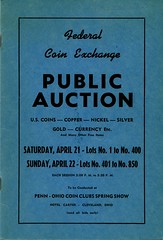 Dan Hamelberg writes:
Dan Hamelberg writes:
Joe Boling writes:
Joe Boling writes:
Bruce W. Smith writes:
Regarding the earlier E-Sylum article on a series of exhibitions focused on French medallic art in the 19th and 20th century,
Tom writes:
 Musée d’Orsay (Paris) – will be exhibiting their medals December 11, 2012 until June 9, 2013
The following link will take you to the d'Orsay's current medal exhibit page.
Musée d’Orsay (Paris) – will be exhibiting their medals December 11, 2012 until June 9, 2013
The following link will take you to the d'Orsay's current medal exhibit page.
(www.musee-orsay.fr/fr/evenements/expositions/au-musee-dorsay/
presentation-generale/article/au-creux-de-la-main-35802.html)
Regarding the Chinese writing for Nummis Nova, Bruce W. Smith writes:
THE BOOK BAZARRE
David Gladfelter writes:
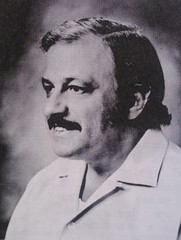 In his 1974 book, Today’s Elongateds, Lee Martin says of him: “One of the most prominent jewelers in New Milford (CT) is also very prominent internationally because of his unique elongated releases. Rosato has produced dies via many methods. He is an expert in hand engraving but this ever curious numismatic scientist is always expanding his talents and has now mastered the art of die etching.”
In his 1974 book, Today’s Elongateds, Lee Martin says of him: “One of the most prominent jewelers in New Milford (CT) is also very prominent internationally because of his unique elongated releases. Rosato has produced dies via many methods. He is an expert in hand engraving but this ever curious numismatic scientist is always expanding his talents and has now mastered the art of die etching.”
Tom DeLorey writes:
In our December 23rd issue Gosia Fort wrote (regarding a collection of medical medals residing at the University of Pittsburgh):
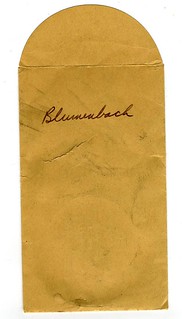
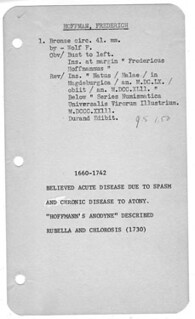
Mark Van Winkle of Heritage writes:
COIN DEALERS AND DALLAS/FORT WORTH, TEXAS
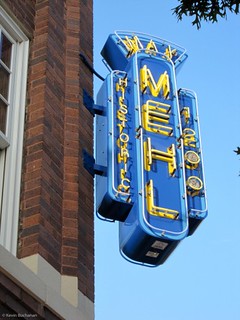 Dave Lange passed along this interesting item he found on the PCGS message board.
Dave Lange passed along this interesting item he found on the PCGS message board.
MORE ON THE 1902 PARIS IN LONDON EXHIBITION MEDAL

QUERY: BOGHOS PASHA NUBAR MEDAL INFORMATION SOUGHT
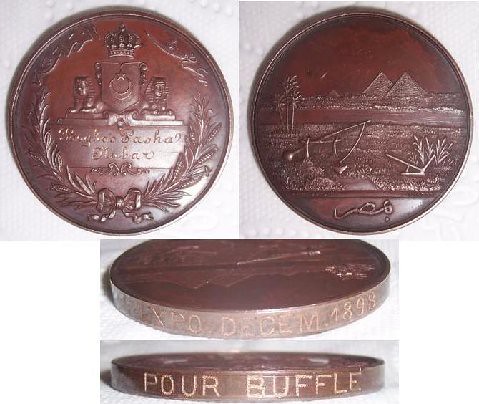
QUERY: HOW WAS THE ALASKA PURCHASE CHECK REDEEMED?
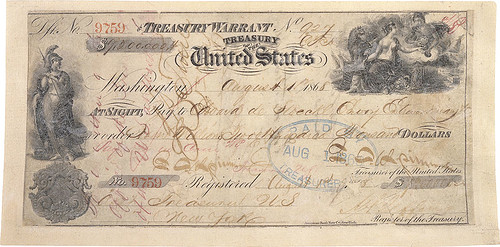
QUERY: ARMS OF DUNKIRK MEDAL BY ROETTIERS INFORMATION SOUGHT

THE OBITUARY OF JULES FONROBERT
 Attached is the obituary for Jules Fonrobert, the German original as well as my translation.
It was my opinion that little was known about Fonrobert and I heard even of the assumption that he did not exist and that 'Fonrobert' was only an alias for the real owner of the collection.
Attached is the obituary for Jules Fonrobert, the German original as well as my translation.
It was my opinion that little was known about Fonrobert and I heard even of the assumption that he did not exist and that 'Fonrobert' was only an alias for the real owner of the collection.

Dr. Feodor Foerster
Translated by Ralf W. Böpple, November 2012
(1) Translator’s note: this date is clearly too late and should most likely read 1868
COINS MAILING LIST TO SHUT DOWN

DAVE BOWERS ON NUMISMATIC LITERATURE IN THE 1950S
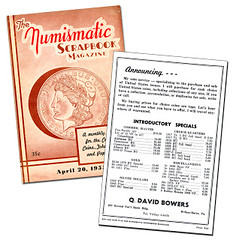 The annual convention of the American Numismatic Association was held in Omaha in 1955. I was there, and it was my first, although I had attended other shows—mostly those of the Empire State Numismatic Association (ESNA).
The annual convention of the American Numismatic Association was held in Omaha in 1955. I was there, and it was my first, although I had attended other shows—mostly those of the Empire State Numismatic Association (ESNA).
QUERY: INFORMATION ON AUTHOR STARR GILMORE SOUGHT
WILL CANADA ELIMINATE NICKEL NEXT?

VENDING MACHINES CAN'T ACCEPT NEW $20 BANK NOTE
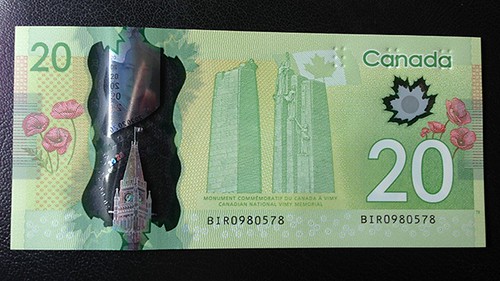
-new-20-bank-note-1.1102682)
BRITISH MUSEUM ACQUIRES SOUTH POLE EXPLORER SCOTT'S MEDALS
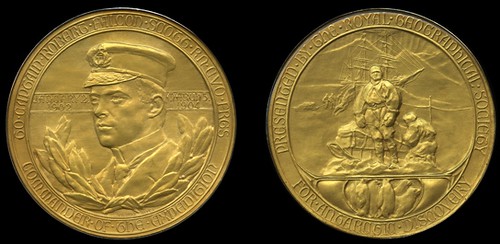
-awarded-to-captain-scott/)
PERTH MINT ISSUES HOLEY DOLLAR AND DUMP
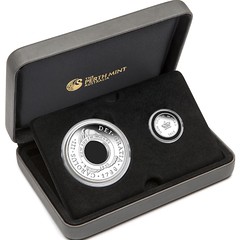 As the first coins struck in New South Wales, the Holey Dollar and Dump hold an unequalled place in Australian numismatic history. In the early 1800s the colony had moved on from being a mere penal outpost and was fast developing into a well-established settlement, however, there was still no local currency.
As the first coins struck in New South Wales, the Holey Dollar and Dump hold an unequalled place in Australian numismatic history. In the early 1800s the colony had moved on from being a mere penal outpost and was fast developing into a well-established settlement, however, there was still no local currency.
JANUARY 2013
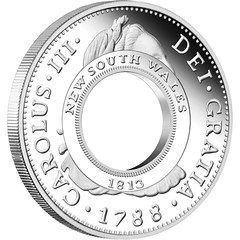
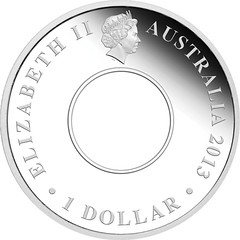


-and-dump-2013-silver-proof-coin-set.aspx)
TEENAGER CAMPS OUT TO BE FIRST AT ROYAL AUSTRALIAN MINT SALE
 A 13-year-old Sydney teenager has collected the first coin of 2013 after spending four days camped outside the Royal Australian Mint in Canberra.
A 13-year-old Sydney teenager has collected the first coin of 2013 after spending four days camped outside the Royal Australian Mint in Canberra.
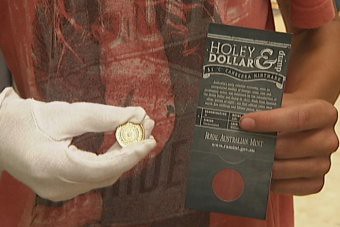 Harley, who turned down an $800 offer from a rival collector to sell the coin, says it was fun camping out over the weekend with his three brothers.
Harley, who turned down an $800 offer from a rival collector to sell the coin, says it was fun camping out over the weekend with his three brothers.
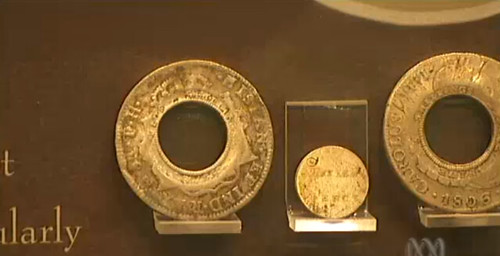
-coin-pays-off/4449332)
THE BOOK BAZARRE
ODYSSEY MARINE FACES OPPOSITION TO HMS VICTORY RECOVERY PLANS
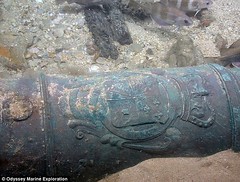 U.S. bounty hunters should not be allowed to raise the wreck of one of Britain's greatest warships and take some of the millions of pounds of gold it contains, it has today been claimed.
U.S. bounty hunters should not be allowed to raise the wreck of one of Britain's greatest warships and take some of the millions of pounds of gold it contains, it has today been claimed.
-submit-plans-raise-gold-coins-worth-hundreds-millions-wreck-HMS-Victory.html)
A BOOKCASE/STEAMER TRUNK
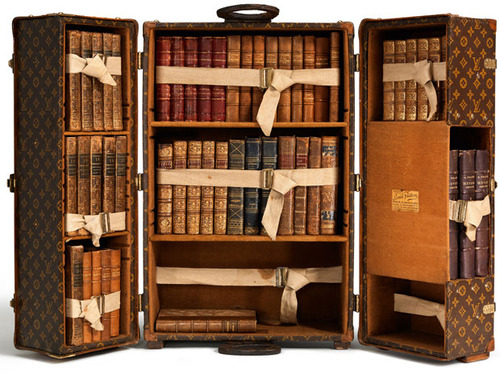
BOOK TRANSFORMS INTO PORTABLE TOILET
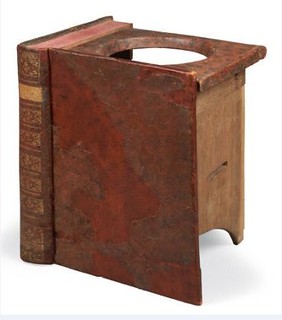
THE BOOK BAZARRE
FEATURED WEB SITE: WORLD OF COINS
This week's Featured Web Site is the World of Coins forum, suggested by Peter Kraneveld, who writes:
![]()
www.worldofcoins.eu/forum/

